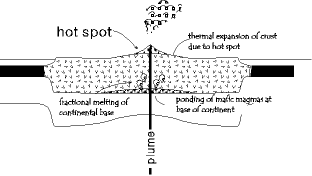  Into the peaceful stable continent of Stage A comes a disturbance. From deep in the mantle a plume of hot mafic or ultramafic magma, rises toward the surface and ponds at the base of the continent creating a hot spot. Heat from the hot spot warms the continental crust causing it to expand and swell into a dome 3-4 kilometers high and about a thousand kilometers in diameter.  As the dome swells it thins and stretches like pulled taffy (or silly putty) until the brittle upper surface cracks along a series of three rift valleys radiating away from the center of the hot spot. These form a triple junction. Details of early rifting. Ideally the three rift valleys radiate from the center at 120o, but often the triple junction is not symmetrical and arms may diverge at odd angles. Rifting is splitting the original continent into two pieces, west and east, although they are still connected at this stage. As the dome swells it thins and stretches like pulled taffy (or silly putty) until the brittle upper surface cracks along a series of three rift valleys radiating away from the center of the hot spot. These form a triple junction. Details of early rifting. Ideally the three rift valleys radiate from the center at 120o, but often the triple junction is not symmetrical and arms may diverge at odd angles. Rifting is splitting the original continent into two pieces, west and east, although they are still connected at this stage.Mafic volcanism is normal and appears as intrusive sills, or vent volcanos and/or flood basalts from fissure volcanos rising along feeder dikes. The volcanics may be mostly volcaniclastic, or lava flows of vesicular and columnar-jointed basalt. Subaqueous pillow basalts are not unusual in later stages. Mafic (hot spot) volcanoes are common and appear as vent volcanos and/or flood basalts from fissure volcanos in the rift. Commonly the intense heat of the hot spot will fractionally melt the lower continental crust composed of granodiorites or plagiogranites. The results are alkali granitic magmas that rise to emplace as batholiths, frequently sending conduits to the surface to create large felsic volcanoes. The simultaneous formation of these two very different rock types (one from the bottom and one from the top of Bowen's Reaction Series) is called a bimodal distribution. Active Rifting Axial rifts are typically tens of kilometers across, and the elevation from the rift floor to the mountain crests on either side are as much as 4-5 km. Structurally, rift valleys are block-fault graben bordered by horst mountains on either side (see Hot Spot/Thermal Doming cross section). The edges of the major horsts bordering the axial graben are the continental terraces (also called hinge zones) (see Foundering of Rift Valley/Marine Invasion cross section). The major axial graben contains numerous smaller horsts and graben. The normal faults are listric type. The fault surfaces are curved so that the graben blocks rotate as they subside, trapping small basins between the down faulted-block and the wall behind the fault. It is also typical for numerous, smaller lateral graben to form for several hundred kilometers on either side of the axial graben. Initially the axial valley floor is subareal, that is above water (except for lakes), but in time the axial graben subsides and the sea invades creating a narrow marine basin (making it subaqueous). A diversity of sedimentary rocks are deposited in the graben, mostly in short system environments where facies changes are very rapid. The horst mountain highlands are composed of felsic and high grade metamorphic continental basement which erode rapidly to coarse, subareal arkosic breccias and conglomerates (fanglomerates) (red field on the QFL diagram). All around the basin edges, at the base of the fault scarps, these accumulate in steep-faced alluvial fans. Away from the alluvial fans, toward the basin axis, the fans give way to braided rivers and then often lakes. See reconstructions for the Rifting of Pangaea. The lakes are trapped depressions created when the graven floors drop and pond the water. Many of the lakes are very deep and, based on modern rift lakes, may be extremely alkaline with salt crusts floating on the surface. In the lake bottoms black, organic rich, anoxic clays accumulate because there is no circulation or oxygen in the deep water. After the sea invades the rift, fan deltas develop. Here alluvial fans still form next to the mountains but now turbidity currents rather than braided rivers transport sediment toward the basin center. The basin center is still frequently deep and anoxic, and thinly laminated black clays and silts are deposited. Thousands of meters of sediment may accumulate during this stage. In a geologically short time (~ 10 million years) the basin finishes filling. As the former great relief of the horst mountains and deep graben smooth out, shelf and near-shore deposition takes over. Sands now dominate and abundant cross beds and ripples indicate shallow water processes. By this time the Early Divergent Margin stage is beginning (Foundering of Rift Valley). |